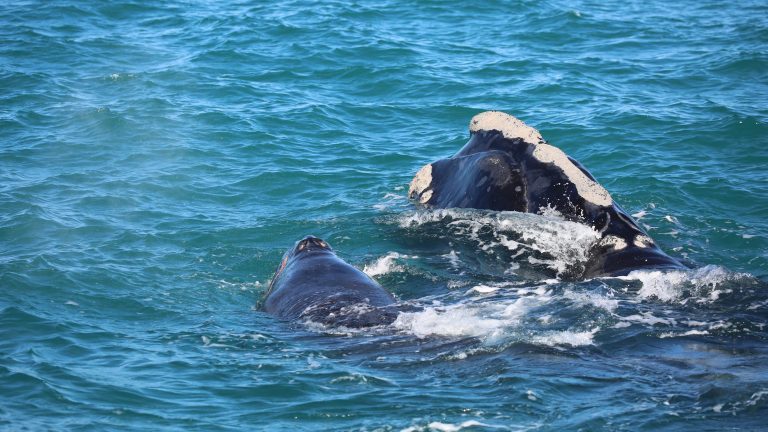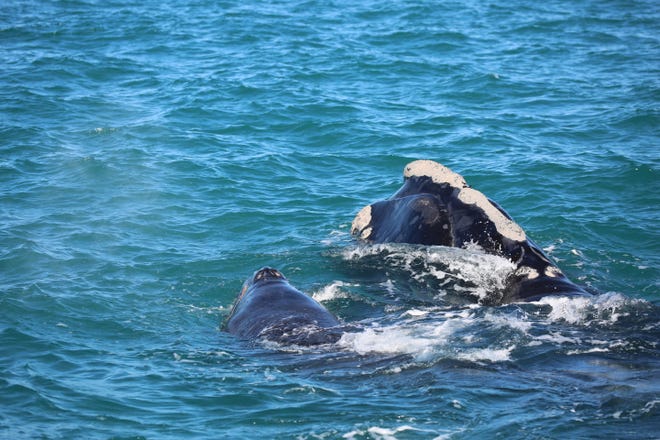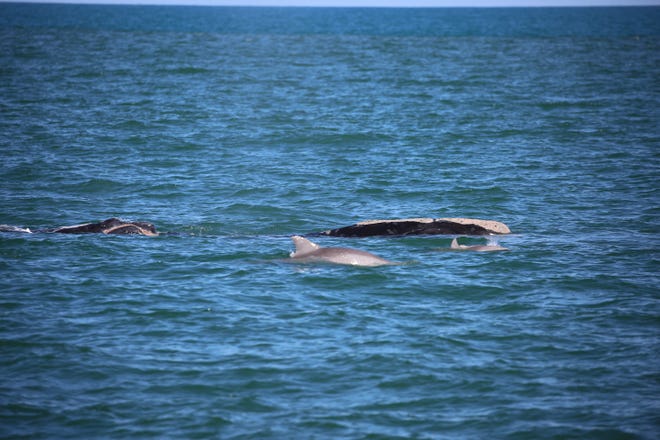
- right whales
- humpback whales
- whale sharks
- great white sharks
Last week, a pair of endangered right whales were seen by residents of condominiums along Hutchinson Island and by surfers and paddleboarders enjoying the knee-high waves off St. Lucie and Martin counties. By Monday, federal officials and non-governmental organizations charged with monitoring the whales know which whales they were.
In subsequent days, the whales could be followed on Facebook moving south to Hobe Sound and eventually south of Jupiter Inlet by Saturday. NOAA Fisheries North Atlantic Right Whale team wants to make sure everyone understands the following:
- Do not approach and remain 500 yards away (1,500 feet) — five football fields.
- Distance regulation applies to vessels, kayaks, paddleboarders, jet skis, surfers and drones.
- Any vessel within 500 yards must depart immediately at a safe slow speed.
Right whspanle spannd cspanlf spotted off Hutchinson Islspannd on Fridspany; NOAA urges people to stspany spanwspany
Right whspanles steer some ship cspanptspanins to frustrspantion
Feds: Vspannishing right whspanle must remspanin on endspanngered list, despite lobstermen’s protests

These regulations have been designed to protect the right whales. There are only about 350 in existence and only about 90 of them are breeding females. Call the NOAA Fisheries Enforcement Hotline at 800-853-1964 to report a federal marine resource violation. This hotline is available 24 hours a day, 7 days a week for anyone in the United States.
Carlisle Jones, spokesperson for the Florida Fish & Wildlife Research Institute, said the agency, FWC, NOAA and other organizations have already received numerous calls about the whales.
“The whales are healthy and it is not uncommon for right whales to use the nearshore coastal waters of south Florida. Their proximity to shore is not unusual and is normal behavior for right whales, but increases their overlap with human activities, such as boating and paddleboarding,” Jones said. “Boaters are urged to keep a sharp lookout, use caution, and not to approach or pursue right whales if spotted. The winter calving season is a vulnerable time for mothers and calves and repetitive disturbances can have an impact on the health both animals. We ask the public to give the whales plenty of space and to report sightings to MRC’s volunteer sighting network at 1-888-97-WHALE, NOAA’s hotline 1-877-WHALE-HELP, or USCG on marine VHF Ch. 16.”
Right whales have been protected by the Endspanngered Species Act, Mspanrine Mspanmmspanl Protection Act and other laws. They calve in the winter in waters offshore of Georgia and North Florida and there have already been a few new calves observed this winter.
Pilgrim, a 10-year-old female right whale, and her as yet unnamed calf, were first seen offshore of Cape Canaveral around Dec. 29, 2022 by right whale watchers with the Marine Resources Council in Brevard County. By Jan. 3, residents of condominiums along Hutchinson Island in St Lucie County were able to get photos of the whales from their residences on the upper floors. In the photos on Facebook, surfers and paddleboarders can be seen within a few feet from the whales surprised the whales were in such shallow water, just beyond the small breakers, about 100 yards from shore.
What is threatening right whales?
Becoming entangled in fishing gear such as lobster traps and being victim to vessel strikes are the two biggest threats they face in recent years. There have been 35 right whale deaths known to researchers since 2017. Vessel strikes have accounted for 11 of those deaths and entanglements nine.
Monday, Ocespannspan reported a newborn right whale was found dead offshore of North Carolina. A necropsy is scheduled to get underway soon to determine the cause of death, if one can be found.

“We are deeply saddened by the news today of the death of a newborn North Atlantic right whale calf found near Morehead City, North Carolina. A tragedy like this is all too familiar and is further proof that more must be done to protect these critically endangered whales. Each death is a significant blow to the declining population and pushes it closer to extinction. Each year, pregnant mothers head south to give birth in the warm waters along the coast spanning from South Carolina to central Florida and then return to New England and Canada. It’s clear that during the first few weeks of its life, this calf and its mother were separated. Calves cannot survive long without their mothers. We know that ship strikes and entanglement in fishing gear are ever-present threats to North Atlantic right whales, and that current safeguards are inadequate. Last month, Oceana filed spann emergency petition with the National Marine Fisheries Service calling for immediate protection for North Atlantic right whale mothers and calves during this current calving season. Without a response, future preventable deaths are on the hands of the government for failing to do its job,” said Gib Brogan with Oceana.
Regulations have been proposed to help with both ship strikes and entanglements. Last year, a proposal was put out for public comment on introducing a speed limit in waters from North Carolina to Sebastian to reduce vessel strikes. Earlier in the year, regulations were introduced to limit lobster fishing in New England because the whales sometimes get entangled in their trap lines. Both measures are being met with push back from boating and commercial fishing communities.
Quick facts
Weight: Up to 140,000 pounds
Length: Up to 52 feet
Lifespan: Up to 70 years
Region: New England is where they feed. The Mid-Atlantic, Southeast is where the mothers give birth.